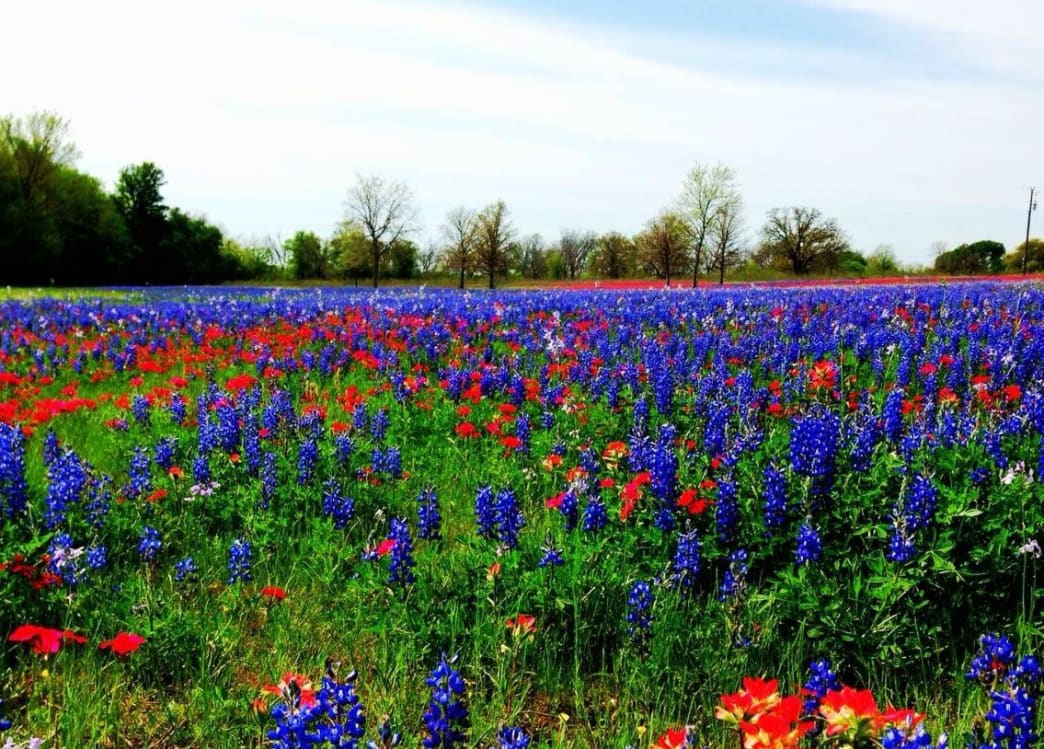
Alterations
Description
These would come in handy too...

As Robert Earl Keen said, “The road goes on forever and the party never ends." Every time I sing that line I can’t help but think that Texas must have been on his mind when he penned that song. After all, backroads and bars—both housing equal degrees of character—are quite abundant in the Lonestar State.
That lyric rings particularly true when the mild Texas winter shifts to springtime in early March. What Texas lacks in seasons, it certainly makes up for each spring. With more than 5,000 species of flowering plants, only California rivals Texas in its abundance of blossoms within the contiguous United States.
I’ve come to pay close attention to how Texas wildflowers blossom in waves, with bluebonnets usually being the first to arrive, seemingly overnight. So long as the rain’s been hearty and there have been no unseasonably tardy freezes (which are quite rare), the color patterns are both vibrant and predictable.
Fields of blue quickly become fields of blue and yellow when the yellow groundsel begins blooming. And fields of blue become fields of blue and red when the Indian paintbrushes follow suit, painting whole meadows with their bright red petals. Pink evening primrose and their delicate ballet pink petals take up entire countrysides. Red poppies grow in abundance too.
When these magnificent springtime displays are at their peaks—usually early March through early May—there is no better time to hit the road and explore Texas.
And Texas, of course, with its endless bounty of rural county, farm-to-market, dirt, and ranch roads, provides endless routes for exploration, and endless opportunities for pit stops. Whether old farms, historic markers, or dive bars are your fancy, off-the-beaten-path meanderings through the Lonestar State are fruitful. I favor all the above.
Come spring, I’m rarely found in the city, rather exploring perfected routes from years of adventuring, or forging new (to me) directions. While there are well-known scenic routes throughout Central Texas, I recommend getting at least a little lost. I may not be good at many things, but scouting wildflower meadows, local grandads, and dive bars are my forte. Welcome to one of my go-to, roundabout, country-cruisin’, watering hole and wildflower journeys I enjoy each and every Texas spring.
Disclaimer: While this drive can be done in a day, I usually make this particular adventure a weekend-long trip, grabbing an Airbnb along the way. As you read about the watering holes below, you’ll understand.
East of Lockhart, one of Texas’ most well-known BBQ towns, and south of Bastrop, a small town famous for its pines, is a sleepy little place called McMahan, Texas. From Austin, I recommend taking U.S. Route 183 South to Lockhart. (Even though it’s a “main” highway, the wildflower displays are unrivaled.) From Lockhart, you’ll head east to McMahan. Long-abandoned, the town was first called Wildcat and later Whizzerville, before officially becoming McMahan when the Post Office decided there were just too many letters in its former name.
Sitting at the intersection of FM roads 713 and 3158, the restored ghost town is a little-known place perfect for those who appreciate a slow day along country roads, a little history, and old Texas charm. Whether coming from the east or west, McMahan rests in a pocket of rural Caldwell County that guarantees wild colors along the roads on the way into town.
Whizzerville Hall is a perfect stopover for pizza, afternoon brews, and, on occasion, live honky tonk and a little boot-scootin’.
Next, head south to the infamous Shiner, Texas, via Texas Route 304 and U.S. Route 90. It’s a long-time tradition to sip a Shiner at Antiques, Art, and Beer, so you can earn your “I drank a Shiner in Shiner” certificate at the antique store and bar. Shiner is also home to Spoetzl Brewery, where Shiner Beer is brewed. Tours of the brewery are available on weekdays. There's a cozy cabin called Shiner Guesthouse not too far away, if you desire a stopping point. It's a historic cabin in the middle of ranch land, surrounded by wildflowers in the spring. With a front porch overlooking it all, it's a perfect spot for morning coffee before continuing your excursion.
Once you're back on the road, you’ll head north to Moulton via Texas Route 95. Moulton is a quiet town with a local watering hole that’s quite unique—Ole Moulton Bank. Once a bank, the establishment is now a dive bar with walls lined with vintage guitars. Whether you prefer to talk to locals or eavesdrop on their conversations, the bank is a great place to hole up for an afternoon brew. You might just meet a local man who calls himself “Blackbird” and offers to take you hog spottin’. And if you don’t, don't fret—you can always buy a vintage guitar to take with you on the road.
From Moulton, you’ll head north. If you appreciate old churches, Flatonia is home to one of Texas’ twenty famous painted churches: St. Mary’s Church of the Assumption. The cathedral is vibrant and majestic, and certainly worth the field trip, particularly if you’ve found any watering hole mischief along the way.
Your next stop is Cistern, Texas—one of my favorite tucked away places in the entire state. Many drive right on through without as much as a second look, but if you take the time to stop at the Cistern Schoolhouse, you’ll be in for a pleasant surprise. The former schoolhouse has been converted into a small watering hole and, with its original facade, is easy to pass by if you don’t know it’s there—particularly since there's no website or mentions in other travel pieces. (You’re welcome.)
Now for the good stuff: While there is a chalkboard chock full of Texas brews, there are also “homemade spritzers”—brilliantly crafted with Franzia and Sprite. They’re so bad that they’re good. And they're a local staple, so indulge. The owner makes incredible wooden puzzles—the kind most common folk can’t quite figure out, even if you sit there and drink all night. But, he’s always willing to lend a helping hand.
If you’d like to buy your barstool neighbor a beer, ask for a hall pass. The grade of wood determines the quality of the beer, and your gracious neighbor can hang onto it till (s)he’s ready for a refill. When you’re ready for a burger, head just a half mile up the road to the Cistern Country Store. For less than $6, you'll get a half-pound of local beef, and sometimes a leather-pants wearing cowboy with enough twang to convince you to stay for one more beer.
The last town along this route is Smithville, Texas, due north of Cistern. It’s a sleepy (but known) town, with a beautiful main street, famous for being a shooting location for the 1998 film Hope Floats. Huebels Bier Garden is the local spot for jukebox breaks and cold beers. It’s a perfect cap to a weekend-long adventure, where locals give you a warm welcome, and, if you make nice enough, the mayor just might invite you on a poker run.
This entire route, which completes a big ole loop southeast of Austin, will take you through several historic, heritage-rich Texas towns. Far removed from big city livin’, every road along this journey is scenic, and in the springtime, is lined with the waves of Texas wildflowers that make spring here famous. While you should expect the occasional “Yee-haw!” and a good bit of hootin’ and hollerin’, this route is also beautifully quiet. And there's still the thistles to come in June and the single-stemmed rain lilies that bloom after the first autumn rain in September.
As Steinbeck said, "Texas is a state of mind." He was right. The road sure does go on forever. And the party surely never ends.
Written by Ashley Halligan for RootsRated.